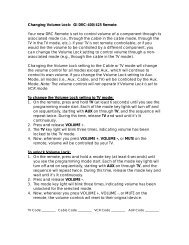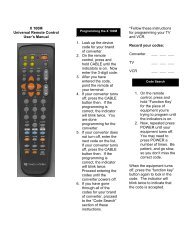View Pause Magazine - Mediacom
View Pause Magazine - Mediacom
View Pause Magazine - Mediacom
Create successful ePaper yourself
Turn your PDF publications into a flip-book with our unique Google optimized e-Paper software.
TV Parental<br />
Guidelines<br />
AND WhAt theY MeAN FOR YOuR ChiLDReN<br />
the guiDelines that DeButeD in 1997 can help parents pick and choose the<br />
programs they deem inappropriate for children of any age due to violence,<br />
sexual content and/or adult language. There are two parts:<br />
A rating that indicates the age group for which a particular program has been produced.<br />
A rating that tells parents if a show has high levels of sex, violence or adult language.<br />
To check a program’s rating, read your local TV program listings or look for the display in the<br />
upper left-hand corner of the TV screen. It appears there for 15 seconds at the beginning of<br />
a show. If a program runs longer than 60 minutes, the broadcast will display the symbol at<br />
the beginning of each hour.<br />
matuRe auDiences only: This program has been produced solely for<br />
adults and may be unsuitable for children under 17. The show may<br />
include graphic violence (V), explicit sexual activity (S) and/or crude,<br />
indecent language (L).<br />
PaRents stRongly cautioneD: This program includes material that<br />
parents may find unsuitable for children under 14. Parents are<br />
urged to exercise more care in monitoring this program, and also<br />
are cautioned against letting children under 14 watch unattended.<br />
This show has intense violence (V), intense sexual situations (S),<br />
strong coarse language (L) and/or intensely suggestive dialogue (D).<br />
PaRental guiDance suggesteD: This program includes material<br />
that parents may find unsuitable for younger children. The theme<br />
itself may call for parental guidance, and/or the program features<br />
moderate violence (V), some sexual situations (S), infrequent coarse<br />
language (L) and/or some suggestive dialogue (D).<br />
geneRal auDience: Most parents would find this program appropriate<br />
for all ages. Although this rating doesn’t signify a program designed<br />
specifically for children, most parents may let younger boys and<br />
girls watch this show unattended. It has little or no violence, no<br />
strong language, and little or no sexual dialogue or situations.<br />
DiRecteD at olDeR chilDRen (fantasy/violence): For programs in<br />
which fantasy violence may be more intense or more combative<br />
than it is in TV-Y7 shows.<br />
DiRecteD at olDeR chilDRen: This program has been produced for<br />
children 7 and up, but may be more appropriate for kids who have<br />
developed the skills to distinguish between make-believe and reality.<br />
Themes and elements in this program may include mild fantasy or<br />
comedic violence, or may frighten children younger than 7. Parents<br />
should consider this program’s suitability for very young children.<br />
all chilDRen: This program is designed for all children. Whether<br />
animated or live action, the show’s themes and elements are aimed<br />
at a very young audience, including 2-to-6-year-olds. This program<br />
isn’t expected to frighten younger children.<br />
The entire TV industry has been strongly encouraged to use these<br />
voluntary guidelines, but not every network or programmer does.<br />
That’s why some programs don’t display a rating, while others<br />
display age ratings but not content labels.<br />
cool foR the kiDs<br />
Use this chart to<br />
track the temp. of<br />
your kids’ viewing.<br />
MOM,<br />
WHAT’S ON TV?<br />
one of kiDs’ toP comPlaints of<br />
our time is: “Mom, there’s nothin’ on TV.”<br />
But how wrong they are, especially<br />
if your household subscribes to <strong>Mediacom</strong><br />
cable service.<br />
In the last 10 years, children’s<br />
programming has been one of the<br />
major growth sectors for networks and<br />
producers on the prowl for new audiences.<br />
No matter if the kids are 2, 6, 10, 12 or 15,<br />
there’s something for all of them at just<br />
about any time of day, depending on your<br />
<strong>Mediacom</strong> system’s channel lineup.<br />
Here’s a sample of today’s children’s<br />
programming, along with websites where<br />
you’ll find more information:<br />
ABC Family (www.ABCFamily.com)<br />
Animal Planet (www.AnimalPlanet.com)<br />
Cartoon Network<br />
(www.CartoonNetwork.com)<br />
Discovery Channel (www.Discovery.com)<br />
The Hub (www.HubWorld.com)<br />
Disney Channel (www.DisneyChannel.com)<br />
Disney XD (www.DisneyXD.com)<br />
Teen Nick (www.TeenNick.com)<br />
Nick at Nite (www.NickAtNite.com)<br />
Nickelodeon (www.Nick.com)<br />
Nick Jr. (www.NickJr.com)<br />
Science (www.Science.Discovery.com)<br />
TLC (www.TLC.com)<br />
TV Land (www.TVLand.com)<br />
READING THE LABEL<br />
�audience type: Shows the<br />
general audience for which<br />
the program was intended.<br />
�content type: Shows<br />
when a program may have higher levels<br />
or occurrences of violence (V), sexual<br />
situations(S), coarse or indecent language<br />
(L), suggestive dialogue – typically about<br />
sex (D) or fantasy violence (FV).<br />
14 PaUSE | ISSUE NO. 19 www.mediacomcable.com








